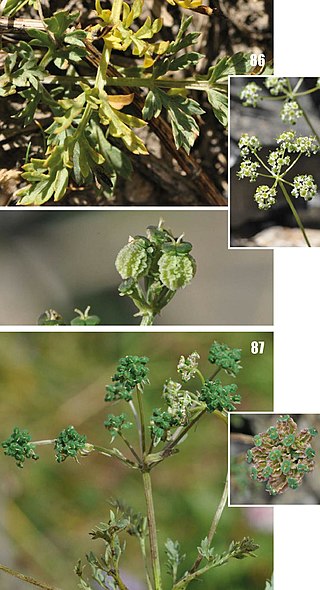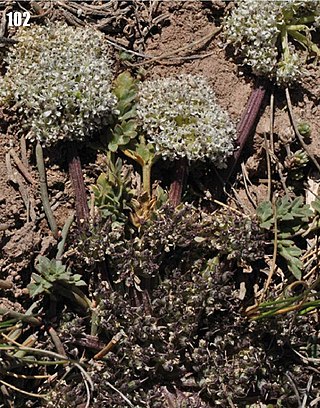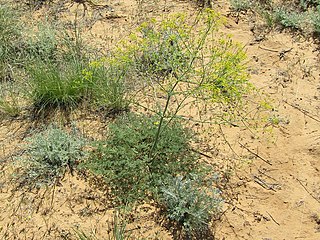
Ligusticum is a genus of about 60 species of flowering plants in the family Apiaceae, native to cool temperate regions of the Northern Hemisphere. Its name is believed to derive from the Italian region of Liguria.

Aulacospermum is a genus of flowering plants in the family Apiaceae, with 15 accepted species. It is endemic to Central Asia and Eastern Europe.
Neoconopodium is a genus of flowering plant in the family Apiaceae, native to Pakistan and the western Himalayas. It may be subsumed into the genus Kozlovia.

Conioselinum is a genus of flowering plant in the family Apiaceae, native to Eurasia and North America. Its species are erect perennial plants with deeply toothed compound leaves and umbels of white flowers. Plants of this genus are known commonly as hemlock-parsley.

Prangos is a genus of flowering plants of the family Apiaceae, native from Europe to Mongolia and the western Himalayas.
Sphaerosciadium is a genus of flowering plants belonging to the family Apiaceae.
Xyloselinum is a genus of flowering plants belonging to the family Apiaceae.
Semenovia is a genus of flowering plants belonging to the family Apiaceae. It is in subfamily Apioideae and also tribe Tordylieae subtribe Tordyliinae.
Elwendia is a genus of flowering plants belonging to the family Apiaceae.

Dimorphosciadium is a genus of flowering plants belonging to the family Apiaceae.

Elaeosticta is a genus of flowering plants belonging to the family Apiaceae.
Hymenidium is a genus of flowering plants belonging to the family Apiaceae.

Ligusticopsis is a genus of flowering plants belonging to the family Apiaceae.
Oreocome is a genus of flowering plants belonging to the family Apiaceae.
Sinocarum is a genus of flowering plants belonging to the family Apiaceae.

Neogaya is a monotypic genus of flowering plants belonging to the family Apiaceae. It contains just one species, Neogaya simplex, and can be found in Europe, the Alps, the western and southern Carpathians, former Yugoslavia, Belarus. European Russia, Kazakhstan, China, and western Siberia.
Pterocyclus is a genus of flowering plant in the family Apiaceae, native from the Himalayas to south-central China and northern Myanmar. The genus was first described by Johann Friedrich Klotzsch in 1862.
Hansenia is a genus of flowering plant in the family Apiaceae, native to from Siberia to China. The genus was first described by Nikolai Turczaninow in 1844.

Conioselinum anthriscoides, more commonly known as Ligusticum sinense, is a species of flowering plant in the genus Conioselinum. It is native to Southern China and is used in traditional Chinese medicine as two separate herbs, both derived from the rhizome and roots of the plant: gaoben (藁本) and chuanxiong (川芎). These two differ by the exact cultivar used; specifically, chuanxiong is derived from the 'Chuanxiong' cultivar only.







